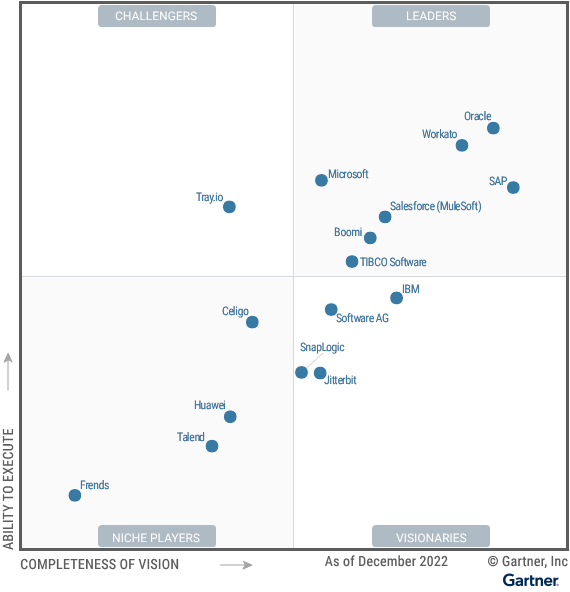I am pleased to share that Oracle has been named a Leader in the 2023 Gartner® Magic Quadrant™ for Integration Platform as a Service, Worldwide – the report formerly known as Enterprise Integration Platform as a Service. This is our sixth consecutive occurrence of being named a Leader in the evaluation of 16 vendors in this market.

For the uninitiated, Gartner defines integration platform as a service (iPaaS) as “a vendor-managed cloud service that enables end users to implement integrations between a variety of applications, services and data sources. These integration processes, data pipelines, workflows, automations and services are most commonly created via intuitive low-code or no-code developer environments.” The rapidly growing iPaaS market is fueled by the need of organizations in all industries to quickly innovate and streamline operations via the use of data.
Oracle has been placed highest for its “Ability to Execute” (vertical axis). We believe this reflects customers’ strong success in using Oracle Cloud Infrastructure (OCI) integration services to connect their applications, data, and APIs across distributed cloud environments – which in turn helps accelerate digital transformation initiatives by automating their business processes and enabling continuous innovation and extendibility across their app portfolio and industry-specific use cases.
In other words, by enabling the flow of timely, trusted information within and across applications and entities, OCI integration services help customers to remove friction and become more efficient.

Oracle is two for two
We feel that being recognized a Leader by Gartner for iPaaS is doubly impressive because it complements Oracle’s similar standing in the 2022 Gartner Magic Quadrant for Data Integration Tools, in which we were also named a Leader (for the 14th consecutive year).
Gartner defines data integration as “the discipline comprising the architectural patterns, methodologies and tools that allow organizations to achieve consistent access and delivery of data across a wide spectrum of data sources and data types to meet the data consumption requirements of business applications and end users. Data integration tools enable organizations to access, integrate, transform, process and move data spanning various endpoints and across any infrastructure to support their data integration use cases….”
In our opinion, a key reason for our data integration tools success is our unified development, operations, and support strategy across engineering teams spanning Oracle Cloud Infrastructure, Oracle Database, Oracle GoldenGate, and more. Our latest cloud deployments appeal to both Oracle’s large existing install base as well as our newest cloud-only customers.
I believe what’s notable about our position as a Leader in these reports is that we have the services, tools, and experience to address a very broad swath of customer needs – in other words, not just application integration and not just data integration, but their combination. Indeed, Oracle capabilities span application, data, and device integration across clouds, on-premises data centers, and/or edge end points such as phones, tablets, kiosks, and vehicles.
It truly seems there are no applications or data silos that cannot be connected by using OCI integration services.

Oracle’s iPaaS differentiators
What does Oracle offer for iPaaS which others do not? Here are five differentiators for OCI integration services:
1) Oracle supports myriad integration use cases, including application integration, data integration, process automation, real-time insight, API management, data quality, streaming, business continuity, and more.
- Other competitors may have limited offerings in either process automation or in data integration. In contrast, Oracle has proven strength across the gamut – covering application integration, process automation, and data as the critical building blocks needed for addressing modern integration needs.
2) Oracle is both easy to use and can address the most demanding performance requirements. We make it simple on the front end for citizen integrators to get going quickly via a sophisticated and intuitive low code environment – while at the same time supporting billions of low-latency messages on the back end to accommodate the scale and performance that our customers require for the critical processes that drive their business.
- Other vendors’ products may require advanced coding skills using proprietary development languages that lock customers into niche technologies or are limited in their ability to perform well at scale, which bogs down customers’ ability to extract the most from their applications and data assets.
3) Oracle integration services pricing is cost effective and not based on connections. With us, the cost is based on service consumption, not an arbitrary metric such as number of connections, so customers only pay for what they use – with enterprise support included in the subscription at no extra charge.
- Connections-based competitors’ pricing often seems inexpensive to start but becomes very costly as connections increase (which is common as enterprises increase their usage of, and reliance upon, applications as the lifeblood of the business). Many organizations continuously integrate increasing quantities of data sources and processes from across their portfolio to support digital transformation.
4) Oracle integration services complement a comprehensive set of SaaS, IaaS, and database services. Sourcing from a “full stack” provider like Oracle makes sense because most companies have a heterogeneous and complex portfolio of apps and services that they need to support – either purchased off the shelf, developed on their own, or integrated with external services. As a result, customers’ needs go beyond “just” integration to also include cloud-native app development, AI enhancements to applications, digital assistants/chatbots, security, content and experience, business analytics, data management, cost-performant cloud infrastructure and SaaS applications, industry-specific apps, and more. Oracle does it all.
- Point-tools challengers have limited ability to address the broad needs of enterprises, which places undue burden on organizations to manage multiple siloed suppliers and the integration between the different products, thus leading to undue risk, cost, and complexity.
5) Oracle is for more than just for Oracle. Besides being best for integrating Oracle applications (as one would expect), Oracle also supports around 100 non-Oracle SaaS and on-premises apps and enterprise systems of record via pre-built integration flows/recipes, auto association, and auto recommendation; these simplify and minimize customer effort.
- Competitors may have a very limited number of connectors for Oracle applications or other popular ecosystem technologies, or their connectors may have weaker functionality than what Oracle provides natively.
Bottom line: We at Oracle are grateful to our global ecosystem of customers and partners for helping us deliver what it takes to accelerate time to value and increase the collaboration between technical and business experts with rapid iteration. Speed, reliability, scalability, ease of use, and cost reduction are what we’ve heard matter most to enterprises’ modernization success, and OCI integration services help customers innovate at scale to meet their fast-changing requirements and regulatory needs.
Additional resources
- View a complimentary copy Gartner’s 2023 Magic Quadrant for Integration Platform as a Service, Worldwide
- Learn more about Oracle appliation integration services
- Read how OCI integration services have evolved over the past year
- Explore our library of application adapters and prebuilt recipes
- Learn more about OCI Process Automation, a native service to quickly automate approval workflows
Gartner, Magic Quadrant for Integration Platform as a Service, Worldwide, Keith Guttridge et al., 24 January 2023. This report was previously known as Magic Quadrant for Enterprise Integration Platform as a Service.
Gartner, Magic Quadrant for Data Integration Tools, Ehtisham Zaidi et. Al., 17 August 2022.
Gartner does not endorse any vendor, product or service depicted in its research publications, and does not advise technology users to select only those vendors with the highest ratings or other designation. Gartner research publications consist of the opinions of Gartner’s research organization and should not be construed as statements of fact. Gartner disclaims all warranties, expressed or implied, with respect to this research, including any warranties of merchantability or fitness for a particular purpose.
This graphic was published by Gartner, Inc. as part of a larger research document and should be evaluated in the context of the entire document. The Gartner document is available upon request from Oracle.
Gartner is a registered trademark and service mark and Magic Quadrant are registered trademarks of Gartner, Inc. and/or its affiliates in the U.S. and internationally and are used herein with permission. All rights reserved.
